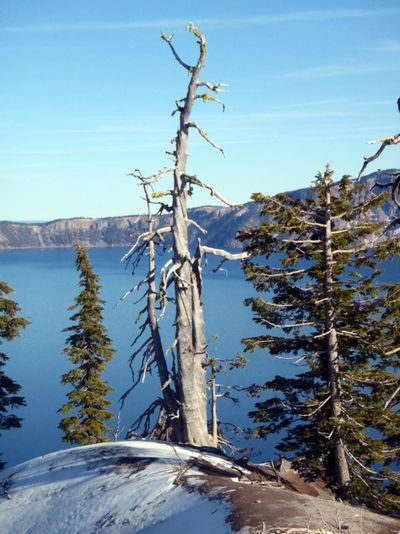Crater Lake whitebark pines infested by beetles

GRANTS PASS, Ore. – The latest mountain pine beetle infestation appears to be slowing down in Eastern Oregon, but not before becoming the leading killer of the signature tree of Crater Lake National Park: the whitebark pine.
Park botanist Jennifer Beck said the beetle now kills more of the gnarled trees that grace the highest elevations of the park than an invasive fungus called white pine blister rust that also attacks them.
“The older trees they are attacking are centuries old,” Beck said. “They are often the biggest cone producers. This impacts regeneration and probably some food for wildlife.”
Countless park visitors have been told the story by rangers of how the whitebark pine depends on the Clark’s nutcracker to regenerate. The bird opens the trees’ cones to get the seeds, and buries them in underground caches for the future. But the birds often forget where they leave the seeds, which sprout before they are eaten.
Now Beck estimates as many as half of them are dead from the combined effects of the beetle and the fungus.
Wide swaths of lodgepole pine have also been turned from green to red by the insect. Park Superintendent Craig Ackerman said timber fallers are cutting dead trees around campgrounds, where they pose a safety hazard, but elsewhere in the park the infestation is considered part of the natural process.
The park is trying to protect whitebark pines by stapling them with a packet that emits an odor telling beetles that this tree is full, and they should find another to feed on.
Park personnel feel it is proper to take this unnatural step because the blister rust that makes the whitebark pine more vulnerable to beetle attack is not a native of North America, having come from Eurasia, Ackerman said.
As long as the dead trees have their needles, they are a fire hazard, but once the needles fall off after a couple years, they are no more likely to burn than living trees, Ackerman said.
The whitebark pine is a candidate for protection under the Endangered Species Act. Threats include the blister rust, pine beetles, wildfire and wildfire suppression, and climate change. The tree has been declining even in areas once thought immune from those threats.
As bad as the beetle infestation gets, things don’t look so bad as forests in the Rockies because many of the forests around Crater Lake are a mix of species, such as mountain hemlock, which is not attacked by the beetles or the blister rust, Ackerman said.